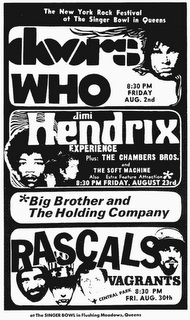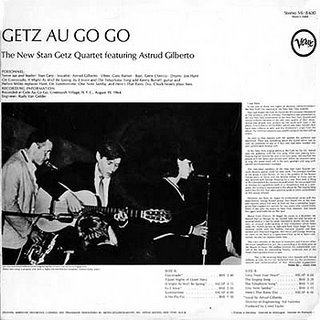

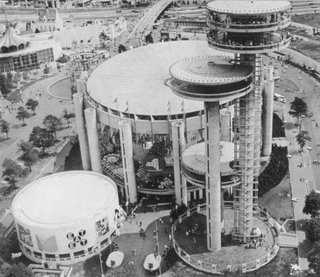
This page is particularly informative on the brief late '60s/early '70s period when the Pavilion was actually in use, first as a cultural institution, then as a roller rink called "Roller Round." Seems like a few rock shows were held there in '69. Steppenwolf, Spooky Tooth, and Rhinoceros shared abill on August 1-2, 1969. Charles Aybar, who worked at the building during that time and is frequently quoted on the nywf64.com page, believes the Byrds played there, but I found no reference to it on a Byrds info site. Similarly, the Grateful Dead is listed here as having played the Pavilion on July 11 and 12, 1969--but I couldn't find a reference to these shows elsewhere. This and other Led Zeppelin websites list a mystery March, 1970 show, but I'm highly dubious--no exact date is cited, and there'd be no logic to an open-air show in cold March when they were easily headlining the likes of Madison Square Garden by then.
[UPDATE 9/28/2007: An exiled Brooklynite named Lewis recently hipped me to the following: "Yes there was a Led Zeppelin show at the Pavilion. I know because I was there. I think the '70 date is wrong, it was more likely '69 since it was early in their career, the same time period when I saw them play at Central Park. And it could have been March because it was not an open air facility, it was definitely indoors. I almost certainly was stoned but I definitely would have noticed if I was outdoors, as opposed to being indoors." Now, this blows my mind. Were temporary walls erected inside the Pavilion during the concert era? Or was the round snack bar building adjacent to the site--later converted into the Queens Theatre in the Park--used for the rock and roll shows?]
[UPDATE 12/15/2012: Jeez, so embarrassing. Obviously I dropped the ball here--but when I put this post together seven years ago, I guess there weren't many super-comprehensive Zep sites around. August 29 and 30, 1969!]
But I'm quite sure about this one, and boy do I wish I could have been there--David Peel and the Lower East Side, The Stooges (apparently in their NYC debut), and the MC5 on September 3, 1969! Here are some eyewitness accounts from Please Kill Me by McNeil and McCain, p. 63 (New York: Grove Press, 1996):
Steve Harris: Iggy looked at the audience, picked his nose, somebody threw a beer can, Iggy threw it back, sang a couple of lines, somebody threw another bottle, the bottle broke on the stage, and Iggy rolled around on it and cut himself all over the place...Alan Vega: The Stooges launched into one of their songs, and the next thing you knew, Iggy was diving off the stage onto the concrete, and cutting himself up with a broken guitar. It wasn't theatrical, it was theater...but with Iggy, this was not acting. It was the real thing. Iggy's set ended in twenty minutes, and somebody had the f**kin' genius to play Bach's Brandenburg Concerto through the speaker system. The audience was throwing bottles and roses at him. I swear it was beautiful...It changed my life because it made me realize everything I was doing was bullshit...the MC5 were one of my favorite bands, but I couldn't watch them after the Stooges. They knew it, too. They were just boogying their ass off all night trying, but baby, they knew they were outdone by Iggy.
And here's some further reportage from Clinton Heylin's From the Velvets to the Voidoids (New York: Penguin, 1993):
On 29, August 1969 both of Detroit's arch-exponents of garage-rock shared a New York bill, at the State Pavilion in Queens. Though the Stooges would later make some of their most infamous appearances in New York, on this occasion they were watched by just a small enclave of New York rock fans who had come to see what all the fuss was about with these Detroit punks. Iggy's final act before leaving the stage was to pick up two drumsticks and "cut long welts into his chest with the tips of the drumsticks."
I know of no other Pavilion shows, and certainly none as cool as that.

After the roller rink operation was shut down, and the unstable fiberglass roof panels were removed rather than repaired, the building was pretty much left to its own devices. I have fond childhood memories of roller-skating and bike-riding over the New York State map on the Pavilion's then still-smooth terrazzo floor (now hopelessly cracked and weed-strewn), and my older brother used to regale me with tales of climbing the towers and making mischief on the observation deck. One of my high school friends had a brother in a band that briefly had a major label contract; I'm "senior momenting" on the band's name, but I distinctly recall that their CD longbox featured pictures of them inside the Pavilion. The site's photogenic potential was also realized in The Wiz, Men in Black, and the video for They Might Be Giants' "Don't Let's Start." But the ravages of time, weathering, vandalism, and neglect have taken their ostensibly irreparable toll on the "Tent of Tomorrow." The Pavilion has been fenced off from public access for many years, and only the most intrepid or morbidly curious of urban explorers dare go beyond the gates. Few ruins have ever looked so anachronously futuristic.
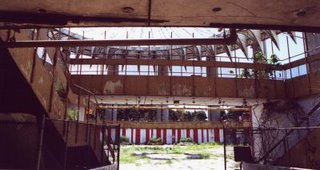
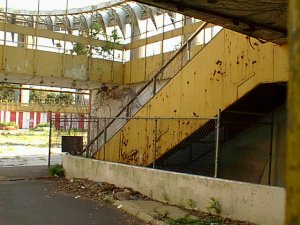
[UPDATE 5/14/2010: I went to see Iron Man 2 last night, and much to my surprise a CGI restoration, or should I say re-imagining, of the fairgrounds plays a major part in the film!!! The Unisphere and particularly the Pavilion are prominently featured, as is a scale model for the so-called "1974 Stark Expo," which was basically a replica of a '64 World's Fair scale model as far as I could tell. See the Bowery Boys and the NY Daily News for more details. And here's a report about current efforts to restore the Pavilion.]
[UPDATE 6/17/2010: Here's an ad for the 1969 season from the 6/5/69 issue of the Village Voice. It's a tad incomplete, so I'll keep looking for revised versions of the ad in the archives.]
[UPDATE 6/25/2010: Here are more 1969 Pavilion ads.]
[UPDATE 11/15/2010: I recently finished Out of the Vinyl Deeps: Ellen Willis on Rock Music (Minneapolis: University of Minnesota Press, 2011), and among its many delights is a 1969 piece about the Pavilion entitled "Summer of Love in Queens." It's a review of a Joe Cocker/Grateful Dead show held there, and includes this description of the milieu:
At the Pavilion, it soon became evident that the rest of the crowd shared our expansive mood. They kept coming in, thousands of happy kids--almost five thousand by the end of the evening. The Pavilion was large enough to accommodate everyone without strain. The ground level served as a huge round dance floor; on the balcony there were tables and chairs, the food concession (the main culinary attraction was tacos, a beautiful idea, though the reality was mediocre), and a nice view of the park. The atmosphere was totally relaxed. As in the San Francisco ballrooms, people were free to dance, crowd in front of the stage, sit in a corner, wander around, eat, or do whatever impulse dictated. There were no intrusive guards or cops.]
[UPDATE 3/15/69 issue: Revised and improved post on 1969 Pavilion ads here.]

